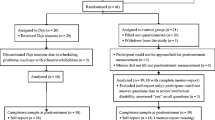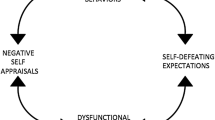Abstract
This paper describes the treatment of an adolescent girl (age 16) who received the ACT with RAGE-Control intervention during her treatment in an urban inpatient psychiatry unit. ACT with RAGE-Control utilizes five traditional Cognitive Behavioral techniques combined with an active biofeedback videogame designed to strengthen a patient’s self-regulatory capacities while facing simulated stress in a virtual environment. The treatment is delivered as daily individual psychotherapy sessions over five consecutive days of an inpatient psychiatric admission. The following case illustrates the theory and techniques of the ACT with RAGE-Control intervention.
Similar content being viewed by others
References
Berenbaum, H., Raghavan, C., Le, H., Vernon, L. L., & Gomez, J. J. (2003). A taxonomy of emotional disturbances. Clinical Psychology: Science and Practice, 10(2), 206–226.
Bornmann, B. A., Mitelman, S. A., & Beer, D. A. (2007). Psychotherapeutic relaxation: How it relates to levels of aggression in a school within inpatient child psychiatry: A pilot study. The Arts in Psychotherapy, 34(3), 216–222.
Chambless, D. L., & Ollendick, T. H. (2001). Empirically supported psychological interventions: Controversies and evidence. Annual Review of Psychology, 52, 685–716.
Deffenbacher, J. L., Oetting, E. R., Huff, M. E., Cornell, G. R., & Dallager, C. J. (1996). Evaluation of two cognitive–behavioral approaches to general anger reduction. Cognitive Therapy and Research, 20(6), 551–573.
Donovan, A., Plant, R., Peller, A., Siegel, L., & Martin, A. (2003). Two-year trends in the use of seclusion and restraint among psychiatrically hospitalized youths. Psychiatric Services, 54(7), 987–993.
Edlund, M. J., Wang, P. S., Katz, S. J., Lin, E., & Kessler, R. C. (2002). Dropping out of mental health treatment: Patterns and predictors among epidemiological survey respondents in the United States and Ontario. American Journal of Psychiatry, 159(5), 845–851.
Elliot, R., & Wexler, M. M. (1994). Measuring the impact of treatment session: The session impact scale. Journal of Counseling Psychology, 41(2), 166–174.
Hains, A. A., & Szyjakowski, M. (1990). A cognitive stress-reduction intervention program for adolescents. Journal of Counseling Psychology, 37(1), 79–84.
Jacobson, E. (1962). You must relax. New York: McGraw-Hill.
Kahn, J., Ducharme, P., Travers, B., & Gonzalez-Heydrich, J. (2009). RAGE control: Regulate and gain emotional control. Studies in Health Technology and Informatics, 149, 335–343.
Kazdin, A. E. (2007). Mediators and mechanisms of change in psychotherapy research. Annual Review of Clinical Psychology, 3, 1–27.
Masters, K. J., Bellonci, C., Bernet, W., Arnold, V., Beitchman, J., Benson, R. S., et al. (2002). Practice parameter for the prevention and management of aggressive behavior in child and adolescent psychiatric institutions, with special reference to seclusion and restraint. Journal of the American Academy of Child and Adolescent Psychiatry, 41(2 Suppl.), 4S–25S.
Nickel, C., Lahmann, C., Tritt, K., Loew, T. H., Rother, W. K., & Nickel, M. K. (2005). Short communication: Stressed aggressive adolescents benefit from progressive muscle relaxation: A random, prospective, controlled trial. Stress and Health: Journal of the International Society for the Investigation of Stress, 21(3), 169–175.
Rice, B. J., Woolston, J., Stewart, E., Kerker, B. D., & Horwitz, S. M. (2002). Differences in younger, middle, and older children admitted to child psychiatric inpatient services. Child Psychiatry and Human Development, 32(4), 241–261.
Ronan, K. R., & Kendall, P. C. (1997). Self-talk in distressed youth: States-of-mind and content specificity. Journal of Clinical Child Psychology, 26(4), 330–337.
Sheeran, P., Aubrey, R., & Kellet, S. (2007). Increasing attendance for psychotherapy: Implementation intentions and the self-regulation of attendance-related negative affect. Journal of Consulting and Clinical Psychology, 75(6), 853–863.
Sourander, A., Jensen, P., Davies, M., Niemelä, S., Elonheimo, H., Ristkari, T., et al. (2007). Who is at greatest risk of adverse long-term outcomes? The Finnish “from a boy to a man” study. Journal of the American Academy of Child and Adolescent Psychiatry, 46(9), 1148–1161.
Spielberger, C. D. (1996). Manual for the state-trait anger expression scale. Odessa, FL: Psychological Assessment Resources.
Sukhodolsky, D. G., Cardona, L., & Martin, A. (2005). Characterizing aggressive and noncompliant behaviors in a children’s psychiatric inpatient setting. Child Psychiatry and Human Development, 36(2), 177–193.
Sukhodolsky, D. G., Vitulano, L. A., Carroll, D. H., McGuire, J., Leckman, J. F., & Scahill, L. (2009). Randomized trial of anger control training for adolescents with Tourette’s syndrome and disruptive behavior. Journal of the American Academy of Child and Adolescent Psychiatry, 48(4), 413–421.
Wolpe, J. (1990). The practice of behavior therapy (4th ed.). Elmsford, NY: Pergamon Press.
Zito, J. M., Craig, T. J., & Wanderling, J. (1994). Pharmacoepidemiology of 330 child/adolescent psychiatric patients. Journal of Pharmacoepidemiology, 3(1), 47–62.
Author information
Authors and Affiliations
Corresponding author
Rights and permissions
About this article
Cite this article
Ducharme, P., Wharff, E., Hutchinson, E. et al. Videogame Assisted Emotional Regulation Training: An ACT with RAGE-Control Case Illustration. Clin Soc Work J 40, 75–84 (2012). https://doi.org/10.1007/s10615-011-0363-0
Published:
Issue Date:
DOI: https://doi.org/10.1007/s10615-011-0363-0




